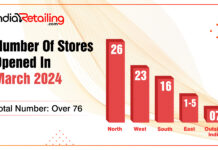A decade ago, e-commerce entered India and changed the lives of urban consumers forever. Today, with the penetration of Internet, e-commerce is changing the lives of Indians in small towns and beyond as well, owing to the convenience and wide variety of choice it affords a consumer. IRCTC, became the first company to create a successful e-commerce portal in 2002 and soon by the revolution of smart phones and easy availability of cheap data, e-commerce made a space of its own in the Indian retail industry. It has been estimated that 1.92 billion global buyers will participate in e-commerce activities in 2019, a number which is expected to swell to more than 2 billion by 2021.
E-Commerce in India
According to an IAMAI-IMRB report, India had an internet base of about 560 million users by December 2018, which is approximately around 45 percent of the population.
Despite the population and also India being the second-largest user base in the world behind China, the penetration numbers of India – in as far as e-commerce is concerned – is low as compared to the American and the European markets. In USA, the e-commerce penetration is above 85 percent whereas European countries like France leads the race with above 80 percent penetration.
A report by Google India says that the Indian e-commerce market was worth about $3.9 billion in 2009. It went up to $12.6 billion in 2013.
In 2013, the e-retail segment was worth US$2.3 billion. There were 35 million online shoppers in India in 2014 and it crossed the 100 million mark by the end of 2016. By 2021 India is expected to generate $100 billion online retail revenue out of which $35 billion will be through fashion e-commerce. Online apparel sales are also set to grow 4X in coming years.
This is not to say that people in India are not furiously shopping online. One reason that people are being attracted towards e-commerce is the demand for international consumer products and brands. The second – and probably the biggest reason is the number of discounts, sale offers, and deals tempting consumers of all ages, especially Millennials. Going by consumer data and popularity, Amazon, Flipkart, ShopClues, PayTm, Snapdeal and eBay are the top e-commerce platforms in India.
Market Scenario
Both Amazon and Flipkart have pumped in millions of dollars into the booming Indian e-commerce market. Amazon had committed an investment of US$ 5 billion– a large chunk of which has already been pumped in across various entities (like wholesale, marketplace and payments) that it operates in India. Flipkart, which saw Walmart picking up 77 percent stake for a whopping US$ 16 billion earlier this year, has also invested in various areas over the years.
ShopClues, India’s first online marketplace honed in on this huge business opportunity and emerged the undisputed leader in its Re-New gadgets category. It clocked a huge Rs 4.5 crore in sales from refurbished and unboxed electronic devices alone, including laptops, smartphones, and tablets, for the month of July. It is also targeting to double its GMV growth by 2019.
“ShopClues had long identified the massive opportunity around the Refurbished category; specially the renewed smartphones segment, which according to industry estimates, is set to grow by over 27 percent in 2019. We have almost doubled our customer base from 8 million to 16 million within 2 years and our success has given us confidence to offer more than 400 stock selling units from different brands in the smartphone category. Also, soon ShopClues will be launching a full assortment of Laptops and TVs from HP, Dell, Apple, Asus, Lenovo, LG, Sony and Samsung for its customers,” explained Radhika Aggarwal, Co-founder & Chief Business Officer, ShopClues.com.
Government Initiatives & FDI
As per IBEF analysis, the Government of India has announced various initiatives namely, Digital India, Make in India, Startup India, Skill India and Innovation Fund. The timely and effective implementation of such programs will likely support the e-commerce growth in the country.
Some of the major initiatives taken by the government to promote the e-commerce sector in India are as follows:
>In order to increase the participation of foreign players in the e-commerce field, the Indian government hiked the limit of foreign direct investment (FDI) in the E-commerce marketplace model for up to 100 percent (in B2B models).
> In the Union Budget of 2018-19, government has allocated Rs 8,000 crore (US$ 1.24 billion) to BharatNet Project, to provide broadband services to 150,000 gram panchayats
> As of August 2018, the government is working on the second draft of e-commerce policy, incorporating inputs from various industry stakeholders.
> The heavy investment of Government of India in rolling out the fiber network for 5G will help boost e-commerce in India.
> In February 2019, the Government of India released the Draft National e-Commerce Policy which encourages FDI in the marketplace model of e-commerce. Further, it states that the FDI policy for e-commerce sector has been developed to ensure a level playing field for all participants. According to the draft, a registered entity is needed for e-commerce sites and apps to operate in India.
Impact of E-Commerce on the Indian Retail Industry
As mentioned earlier, Indian retail industry today revolves around e-commerce. Every person today is connected to e-commerce by his/her smartphone, checking out new arrivals and discounts on a regular basis.
“E-commerce and digitalisation of fashion along with multiple touch points of content consumption has changed the landscape of the retail industry. It has introduced fashion to more people and has greatly expanded the market by ensuring better accessibility to the masses at large. With the launch of our website & mobile app along with making our products available on marketplaces, Lifestyle is steadily transitioning into a true Omnichannel player. The e-commerce platform has shown more growth in the last few quarters,” says Vasanth Kumar, Managing Director, Lifestyle International Pvt. Ltd.
“The e-commerce market is very gigantic and is still expanding at a tremendous rate. The technology associated with e-commerce is taking a forward leap and evolving at a faster pace. Every small to medium size businesses wants to establish a strong online presence, and this has become the need of an hour. We are present across major online portals in India. Not being aggressive on the same has been a business strategy for us, since they follow discounting model. We have recently launched our website for India www.skechers. in which will have almost all products available through-out retail channels of Skechers,” states Rahul Vira, CEO, Skechers, South Asia.
“E-commerce has helped retail industry evolved immensely. While in the past retail industry depended solely on brick-and-mortar to sell with the e-commerce surge, the potential for business has grown overall. Previously only major players like eBay and Amazon were the big players when it came to online selling however it has become an important part of each and every brand to ensure their customers are catered to. We are ensuring a separate strategy is followed for the e-commerce as we cannot have the same plan as the brick and mortar set up. With this in mind a separate price strategy and product offering becomes imperative,” says Asha Esther Jaikishan, Marketing Head, Numero Uno.
E-Commerce & The Beauty Space
The global cosmetics industry too has changed dramatically in the last decade thanks to the rise of trends on social media and the demand for online beauty retailers. Consumers are buying beauty online at a rapid pace. On and offline, skin care remains the top beauty category globally, with a 36.4 percent market share, with China dominating the entire beauty e-commerce market. India is not that far behind and is rising up steadily in this segment.
“Going by the demand, we have penetrated into the metropolitan cities and is slowly and steadily also making our way in the Tier II cities. Individual these days are more conscious of what they use and apply to their skin and want to buy nothing but the best and certified products. To promote these products, we have an extensive online and offline distribution network. Online, we retail on our website, as well as through other e-commerce portals such as Amazon, Flipkart and Elitify. We are also present at the most prestigious salon in India, Silhouette, Salon de Beaute’ at The Oberoi. We are in talks with several other online and offline retailers to expand our network further in the coming year,” says Ragini Mehra, Founder, Beauty Source.
“The growing e-commerce wave is attributable to the ease in use and availability of internet in India. The support from the government in this space has been tremendous and this has been making shopping easy for the consumers too. However, the current wave of e-commerce has been all about the overseas companies capitalising on the Indian market and this has been a major threat to the Indian born e-commerce players. The future of e-commerce in India is definitely on the up-side, however, with less force on policy, a major chunk of that growth could be with the overseas players,” says Naina Ruhail, Co-Founder, Vanity Wagon.
Technological & Innovations Lead to More Growth
Having a smooth and accessible portal for shopping and other retail facilities has to be technologically driven. E-commerce marketplace Flipkart recently introduced the country’s first robot-based sortation technology, automated guided vehicles (AGVs), at its sortation facility in Bengaluru. The brand has introduced over 100 AGVs at its sortation facility, which helps in sorting packages by pin code, leading to an increase in process efficiency. The Soukya set-up involves 100 plus self-guided bots that automatically sort packages to the right customer pin codes by identifying encoded information on each package.
“Growing penetration of smart phones and affordable data plans are now giving easy access to consumers to buy their favourite brands/products online. Lifestyle has embarked on the journey to capitalise on the mobile & e-commerce revolution in India with Omnichannel customerexperience with enabling customers tobuy in-stores or online,” added Kumar.
“With technological advancements the ease to shop and the awareness and information available for customers have also increased. Technology will not only continue to evolve for e-commerce but in other ways that will help brick-and-mortar as well. The rise of e-commerce has given a platform to several retailers to expand their audience in the market. Though the belief remains intact that brick-andmortar format for retail shall continue to grow. The changing landscape presents a great opportunity to tie digital shopping and the in-store experience together, benefitting consumers long-term,” says Vira.
“E-commerce in India is rapidly growing and customers for this industry are growing exponentially as well. Technological innovations like customer engagement driven on analytics, digital payments, advertising and Omnichannel integration has aggravated the growth of e-commerce in India,” explains Jaikishan.
Role of AI, AR, VR & Big Data
“AI & Big Data are definitely helping e-commerce industry sense, predict and automate user experiences at scale and drive store footfalls and sales on the website & apps. AR&VR also has tremendous scope to engage consumers both at our stores and online. This is the area where Lifestyle will explore in depth in the near future,” says Kumar.
“E-commerce is a large space, and all these play a major role in the growth of individual companies and thereby in the industry. That being said, Big Data is the most valuable asset in the space as e-commerce works on large amounts of customer-logistic-inventory data and accurate management and forecasting of the same can get every company a long way. AI again is a widely misunderstood term and it is employed by only the select few in its true sense, hence not making it the most growth dominating factor at present,” explains Ruhail.
Conclusion
The e-commerce industry has been directly impacting all forms of enterprises, be it micro, small and medium in India by providing means of financing, technology and training. The Indian e-commerce industry has been on an upward growth trajectory and is expected to surpass USA to become the second largest e-commerce market in the world by 2034.Technology-enabled innovations like digital payments, hyper-local logistics, analytics-driven customer engagement and digital advertisements will likely support the growth in the sector. The growth in e-commerce sector will also boost employment, increase revenues from export, increase tax collection and provide better products and services to customers in the long-term.








